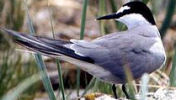Birdwatchers boost NSW economy - bring $200,000 plus to small community
 A group of birds that are not usually found in Australia attracted hundreds of birders to a relatively remote town on the north coast of NSW, resulting in a significant boost to the Australian economy.
A group of birds that are not usually found in Australia attracted hundreds of birders to a relatively remote town on the north coast of NSW, resulting in a significant boost to the Australian economy.
A group of birds that are not usually found in Australia attracted hundreds of birders to a relatively remote town on the north coast of NSW, resulting in a significant boost to the Australian economy.
The new report by UNSW scientists – recently published in the Journal of Ecotourism –estimates that the birders who came to see the Aleutian Terns brought in more than $200,000 in revenue to the NSW economy over about four months.
Aleutian Terns breed in Alaska (USA) and east Siberia (Russia), and usually spend our summer in the North Pacific and parts of Indonesia. To experts’ surprise, they turned up at Old Bar, and on 11 December 2017, Aleutian Terns were photographed using a sandbar that many birders are familiar with for its impressive congregations of shorebirds.
“After word got out to the birding community on 11 December 2017, the who’s who of Australian birders travelled to see these birds until about the end of March 2018,” says study lead author and UNSW Science PhD student Corey Callaghan.
“It was a unique case because there wasn’t just one individual vagrant bird, there were more than a dozen.”
The study by the UNSW Sydney-led team is the first to quantify the economic impact of a vagrant bird – a species observed outside its normal geographic range – in Australia. It estimates the birders’ activity brought between $199,000 - $363,000 to the Australian economy.
The study comes after a similar study published last year, also led by Corey Callaghan, estimated that a single Black-backed Oriole in rural Pennsylvania resulted in more than $US220,000 revenue for that local economy.
“I think together, these studies are demonstrating the exceptional pull of vagrant birds to birders, while also showing the real economic potential of these events. They are contributing to local economies around the world all the time,” Mr Callaghan says.
One of the other authors of the study – Professor Richard Kingsford, Director of the UNSW Centre for Ecosystem Science – says the untapped potential of these visitors also has implications for much-needed increased conservation funding.
“We found that birders were generally conservation aware and would be willing to donate up to $30,000 to view rare birds. Often vagrants are in National Parks and protected areas, providing a potential fundraising opportunity,” he says.
Vagrant bird chasing is just one aspect of the bird watching hobby.
“The total economic benefits of birders, generally, is much higher,” Mr Callaghan says.
“Many birders don’t travel or ‘competitively’ seek out birds; they appreciate them in their local park or bush.”
For example, according to the United States Fish and Wildlife Service, up to $US40 billion dollars per year are spent on watching birds in the US.
“Ultimately, all birds depend on their habitats and so the benefits to the economy from birdwatching need to be factored in as real contributions, stacked up against development threats that destroy their habitats, such as land clearing,” Professor Kingsford says.
“The contribution of biodiversity to the economy is quite clear and needs to be factored in more in the future – at the moment, this is rarely done."

Recent comments